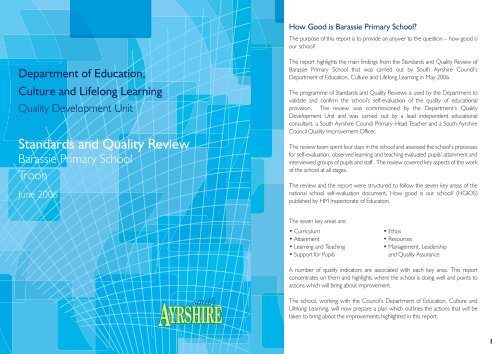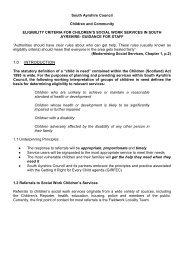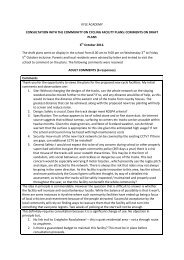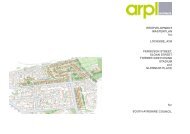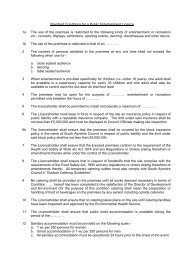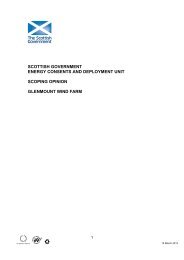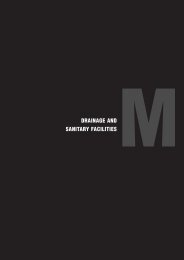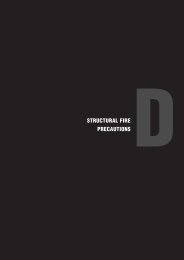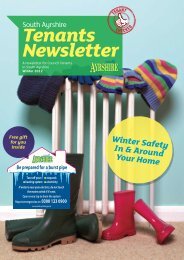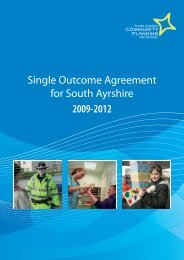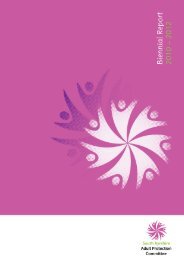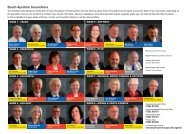How Good is Barassie Primary School? - South Ayrshire Council
How Good is Barassie Primary School? - South Ayrshire Council
How Good is Barassie Primary School? - South Ayrshire Council
Create successful ePaper yourself
Turn your PDF publications into a flip-book with our unique Google optimized e-Paper software.
<strong>How</strong> <strong>Good</strong> <strong>is</strong> <strong>Barassie</strong> <strong>Primary</strong> <strong>School</strong>?<br />
The purpose of th<strong>is</strong> report <strong>is</strong> to provide an answer to the question – how good <strong>is</strong><br />
our school?<br />
The report highlights the main findings from the Standards and Quality Review of<br />
<strong>Barassie</strong> <strong>Primary</strong> <strong>School</strong> that was carried out by <strong>South</strong> <strong>Ayrshire</strong> <strong>Council</strong>’s<br />
Department of Education, Culture and Lifelong Learning in May 2006.<br />
The programme of Standards and Quality Reviews <strong>is</strong> used by the Department to<br />
validate and confirm the school’s self-evaluation of the quality of educational<br />
prov<strong>is</strong>ion. The review was comm<strong>is</strong>sioned by the Department’s Quality<br />
Development Unit and was carried out by a lead independent educational<br />
consultant, a <strong>South</strong> <strong>Ayrshire</strong> <strong>Council</strong> <strong>Primary</strong> Head Teacher and a <strong>South</strong> <strong>Ayrshire</strong><br />
<strong>Council</strong> Quality Improvement Officer.<br />
The review team spent four days in the school and assessed the school’s processes<br />
for self-evaluation, observed learning and teaching evaluated pupils’ attainment and<br />
interviewed groups of pupils and staff. The review covered key aspects of the work<br />
of the school at all stages.<br />
The review and the report were structured to follow the seven key areas of the<br />
national school self-evaluation document, <strong>How</strong> good <strong>is</strong> our school? (HGIOS)<br />
publ<strong>is</strong>hed by HM Inspectorate of Education.<br />
The seven key areas are:<br />
• Curriculum • Ethos<br />
• Attainment • Resources<br />
• Learning and Teaching • Management, Leadership<br />
• Support for Pupils and Quality Assurance<br />
A number of quality indicators are associated with each key area. Th<strong>is</strong> report<br />
concentrates on them and highlights where the school <strong>is</strong> doing well and points to<br />
actions which will bring about improvement.<br />
The school, working with the <strong>Council</strong>’s Department of Education, Culture and<br />
Lifelong Learning, will now prepare a plan which outlines the actions that will be<br />
taken to bring about the improvements highlighted in th<strong>is</strong> report.<br />
1
What the school does well<br />
The pupils are happy, friendly, very well behaved and have a keen sense of identity<br />
with the school.<br />
There <strong>is</strong> a very positive ethos in the school and relationships are based on mutual<br />
respect.<br />
Pupils, staff and parents hold the hard working head teacher in high regard.<br />
All staff work hard, are committed to the school, know the pupils very well and are<br />
very supportive of one another.<br />
National assessment results in the school are very good.<br />
The contribution of pupil support staff to removing barriers to children’s learning <strong>is</strong><br />
effective.<br />
Where the school has areas for development<br />
The school should increase pacing and provide more challenge and rigour for pupils<br />
across the curriculum.<br />
The management team, in consultation with staff, should ensure coherence of<br />
continuity, progression and methodology of curricular implementation across all<br />
stages.<br />
The ex<strong>is</strong>ting programme for monitoring should be extended to increase the<br />
frequency of formal monitoring of pupils’ learning, pacing, attainment and planning<br />
in order to ensure cons<strong>is</strong>tency and progression of pupils’ experiences.<br />
Curriculum<br />
The school provides a broad and balanced curriculum for pupils.<br />
Regular stage meetings afford planned opportunities for curriculum d<strong>is</strong>cussion and<br />
development.<br />
There are very good examples of children’s work on art activities across the stages.<br />
The involvement of v<strong>is</strong>iting special<strong>is</strong>t teachers extends the expressive arts<br />
curriculum.<br />
Very good use <strong>is</strong> made of new technology by staff to deliver the curriculum.<br />
The nursery curriculum, experiences and activities offered to the children are very<br />
good.<br />
The school should give a higher profile to design technology and health education.<br />
The pupils should make more use of information and communications technology<br />
(ICT) across the curriculum.<br />
The school should develop and implement guidance for classroom d<strong>is</strong>play and for<br />
presentation of children’s work.<br />
2 3
4<br />
Attainment<br />
National assessment results for the school are very good.<br />
The school has a tracking system in place.<br />
The school places high importance on the wider achievements of pupils.<br />
The school should undertake a skills based approach to all areas of the curriculum<br />
in order to further ra<strong>is</strong>e attainment.<br />
The school should increase pacing and provide more challenge and rigour for pupils<br />
across the curriculum.<br />
Learning and Teaching<br />
Classrooms are well organ<strong>is</strong>ed and managed across the stages.<br />
Classroom observation identified some very good teaching and learning.<br />
Some children have a range of very good learning experiences, which include taking<br />
responsibility for and being active in their own learning.<br />
Relationships between staff and pupils in classrooms are very good.<br />
In some classes there were good examples of collaborative work by children.<br />
There <strong>is</strong> good use of pra<strong>is</strong>e to encourage pupils across all stages.<br />
Termly newsletters from each stage give parents good information on what their<br />
children are learning in maths, language and environmental studies.<br />
The school should undertake a comprehensive review of forward planning in order<br />
to ensure teaching of skills and clarity in what pupils are expected to learn.<br />
The use of homework and the implementation of the school policy should be<br />
closely monitored to ensure creativity in homework tasks and cons<strong>is</strong>tency of<br />
approach across the stages.<br />
In order to further encourage pupils, more d<strong>is</strong>plays of their work, particularly<br />
written work, should be d<strong>is</strong>played in all classrooms.<br />
The school requires to further develop formative assessment strategies in order to<br />
improve the quality of pupils’ learning.<br />
The school should further develop investigative and independent work and<br />
promote more active learning for pupils.<br />
5
6<br />
Support for Pupils<br />
The level of pastoral care for pupils and staff <strong>is</strong> very good.<br />
There <strong>is</strong> very detailed planning and targeted support for pupils with additional<br />
support needs.<br />
The learning needs of pupils are systematically identified and barriers to learning<br />
addressed.<br />
Lia<strong>is</strong>on with external agencies in order to support pupils <strong>is</strong> very good.<br />
Support staff contribute positively to the children’s learning.<br />
Very good special<strong>is</strong>t v<strong>is</strong>ual impairment support <strong>is</strong> provided by the additional support<br />
needs ass<strong>is</strong>tant.<br />
Standards of pupil d<strong>is</strong>cipline and behaviour are very high supported by good<br />
strategies for promoting positive behaviour.<br />
A wide-range of out-of-school activities supports and encourages pupils.<br />
Support and induction procedures for pupils transferring to the associated<br />
secondary school are very good.<br />
Cross sectoral working parties on language and maths are progressing<br />
primary/secondary curricular lia<strong>is</strong>on.<br />
Nursery/primary curricular lia<strong>is</strong>on should be further developed to ensure more<br />
appropriate pacing at the early stages of the primary school.<br />
Support staff should be deployed more directly to ass<strong>is</strong>t in ra<strong>is</strong>ing attainment of<br />
pupils.<br />
Ethos<br />
There <strong>is</strong> a very supportive ethos within the school to which pupils and staff<br />
contribute.<br />
There are very good relationships at all levels throughout the school.<br />
Staff appreciate the good communication systems in the school.<br />
The school provides a stimulating and secure learning environment for all children.<br />
The school assemblies celebrate successes and the reward systems encourage<br />
pupils and promote their self-esteem.<br />
The Pupil <strong>Council</strong> <strong>is</strong> giving pupils more responsibility and experience in consultation<br />
and dec<strong>is</strong>ion making.<br />
There are high expectations and promotion of achievements in some classes.<br />
There <strong>is</strong> an open door policy for parents and encouragement for them through<br />
information leaflets, newsletters and workshops.<br />
The <strong>School</strong> Board and Parent Teachers Association are very supportive of the work<br />
of the school.<br />
The school makes good use of the local community to extend the curriculum and<br />
the citizenship development of the pupils.<br />
The pupils work hard to ra<strong>is</strong>e money for various charities.<br />
The school should ensure a cons<strong>is</strong>tency of high expectations across the school.<br />
7
8<br />
Resources<br />
The school has an attractive environment and good use <strong>is</strong> made of available space.<br />
Maintenance and cleanliness of the school are very good.<br />
The school <strong>is</strong> well resourced to support learning and teaching and materials are well<br />
organ<strong>is</strong>ed.<br />
The school <strong>is</strong> well staffed with a good mix of experience both in teaching and<br />
support staffing.<br />
The school gives a high level of commitment to continuing professional<br />
development for staff.<br />
A good start has been made to holding regular meetings for support staff.<br />
Management, Leadership and Quality Assurance<br />
The head teacher <strong>is</strong> approachable, committed to the school, hard working and<br />
very well regarded by staff.<br />
Promoted staff are approachable, committed to the school, very supportive to the<br />
head teacher and accessible to staff and parents.<br />
The diligent teaching staff know the pupils well, work as a team and are supportive<br />
of one another.<br />
Staff feel they are consulted and are keen to take on new initiatives.<br />
Ancillary and support staff work very hard and contribute to the ongoing work of<br />
the school.<br />
The operational management of the school <strong>is</strong> very good.<br />
There <strong>is</strong> a good handbook for supply staff.<br />
There <strong>is</strong> a monitoring programme in the school.<br />
Staff, as a team, undertakes self-evaluation using the HGIOS framework.<br />
The management team, in consultation with staff, should ensure coherence of<br />
continuity, progression and methodology of curricular implementation across all<br />
stages.<br />
The management team meetings should focus more directly on learning and<br />
teaching, pace of learning and attainment.<br />
Further developed remits should be drawn up for all members of the management<br />
team and written remits developed for support staff.<br />
The school should continue to work on developing curricular policies and<br />
guidelines to support and guide the work of staff.<br />
The ex<strong>is</strong>ting programme for monitoring should be extended to increase the<br />
frequency of formal monitoring of pupils’ learning, pacing, attainment and planning<br />
in order to ensure cons<strong>is</strong>tency and progression of pupils’ experiences.<br />
Self-evaluation of learning and teaching by staff should be further developed.<br />
9
10<br />
Attainment data and stat<strong>is</strong>tical information about the<br />
school<br />
1. 5-14 attainment levels - percentages of pupils attaining or exceeding appropriate<br />
levels by the end of P3, P4, P6 and P7<br />
5-14 Reading<br />
5-14 Writing<br />
2002/03 2003/04 2004/05<br />
<strong>Barassie</strong> <strong>Primary</strong> 87.4 88.0 93.4<br />
<strong>South</strong> <strong>Ayrshire</strong> (<strong>Primary</strong> <strong>School</strong>s) 83.0 82.4 83.7<br />
2002/03 2003/04 2004/05<br />
<strong>Barassie</strong> <strong>Primary</strong> 79.3 71.1 88.7<br />
<strong>South</strong> <strong>Ayrshire</strong> (<strong>Primary</strong> <strong>School</strong>s) 75.4 73.4 77.3<br />
5-14 Mathematics<br />
2002/03 2003/04 2004/05<br />
<strong>Barassie</strong> <strong>Primary</strong> 90.8 89.8 98.7<br />
<strong>South</strong> <strong>Ayrshire</strong> (<strong>Primary</strong> <strong>School</strong>s) 83.8 85.2 87.7<br />
2. Attendance and exclusion levels<br />
Pupil attendance (percentage)<br />
2002/03 2003/04 2004/05<br />
<strong>Barassie</strong> <strong>Primary</strong> 96.1 96.5 96.6<br />
<strong>South</strong> <strong>Ayrshire</strong> (<strong>Primary</strong> <strong>School</strong>s) 95.3 95.6 95.2<br />
Pupil exclusions (number of incidents) 2002/03 2003/04 2004/05<br />
<strong>Barassie</strong> <strong>Primary</strong> 0 0 0<br />
<strong>South</strong> <strong>Ayrshire</strong> (<strong>Primary</strong> <strong>School</strong>s) 49 54 38<br />
Pupil exclusions ( 1 ⁄2 days lost)<br />
2002/03 2003/04 2004/05<br />
<strong>Barassie</strong> <strong>Primary</strong> 0 0 0<br />
<strong>South</strong> <strong>Ayrshire</strong> (<strong>Primary</strong> <strong>School</strong>s) 203 285 182<br />
3. Information about the school (2005/06)<br />
Pupils information<br />
Number of pupils 306 (including nursery class)<br />
Number of classes 12<br />
Average class size 25.5<br />
Staffing information (full-time equivalent (fte) levels)<br />
Head teacher 1 fte<br />
Depute head teacher 1 fte<br />
Principal teacher 2 fte<br />
Teacher 9.7 fte<br />
Probationer 2 fte<br />
Classroom ass<strong>is</strong>tant 3 fte<br />
ASN ass<strong>is</strong>tant 42.5 hours per week<br />
Clerical ass<strong>is</strong>tant 69.7 hours per week<br />
Nursery nurse 3 fte<br />
Janitor 1 fte<br />
11


